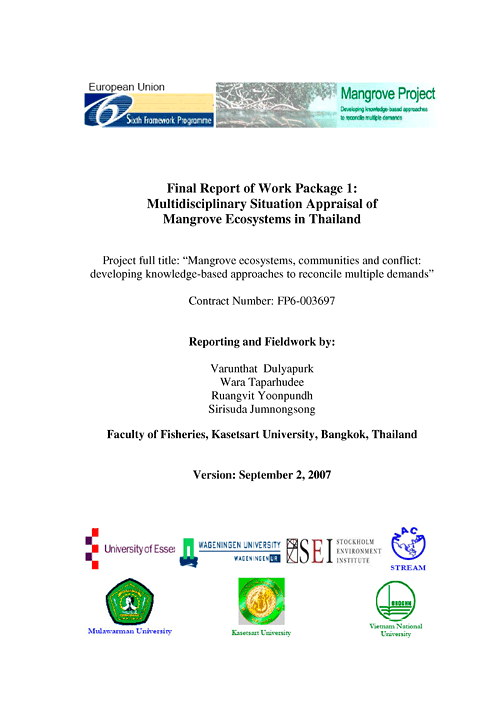Multidisciplinary situation appraisal of mangrove ecosystems in Thailand
20 October 2008 | Varunthat Dulyapurk, Wara Taparhudee, Ruangvit Yoonpundh and Sirisuda Jumnongsong | 747 Downloads | .pdf | 2.14 MB | Livelihoods, gender and social issues, Aquatic plants, Thailand, Markets and trade
The Nakhon Si Thammarat Province from the southern part of Thailand has been selected due to their highest priority and score provided by expert evidence. The 3 communities have been selected to represent different characteristics of the mangrove ecosystem; (1) Ban Kong Khong, Pak Phanang Fang Tawan Ok Subdistrict, Pak Phanang District to represent a community with healthy and old mangrove forest, (2) Ban Pak Nam Pak Phaya, Ta Sak Subdistrict, Mueang District to represent a community with new mangrove plantation areas from abandoned shrimp ponds and (3) Ban Talad Has, Pak Phun Subdistrict, Mueang District to represent a community with new mangrove area from a new sedimentation area, respectively.
The ecosystem health and function (Section 4), including biogeochemical, hydrological and ecological aspects, had been presented based on reviews of published information and data.
The livelihoods of the poor people, goods and services (Section 5) had been analysed based on the Sustainable Livelihoods Framework and Gender Analysis Framework. In general, compared among three communities, Ban Kong Khong had been indicated as the lowest access score to all important assets.
The ranking importance of mangrove goods and services section, for all three communities, had indicated the high level of their income and livelihood dependence on their mangrove system via direct uses of mangrove wood for household use, a prevention of coastal erosion and indirect use benefits from their fishing activities, respectively.
For the mapping flows of goods supporting communities, main targeted species such as, mud crap (Scylla serrata), banana shrimp (Penaeus merguiensis)/ Indian white shrimp (Penaeus indicus) and sesarmid crab (Sesarma eumolpe), for all three communities had been selected for their common harvested species. These fishing products generally passed through their varieties of marketing channels (e.g. middlemen in/outside the communities, local/provincial markets and exported goods to other countries).
The cause ranking of impacts to mangrove forest and mangrove aquatic resources can be categorised into two main causes; natural causes (e.g., erosion and severe storm problems) and human uses (e.g., cutting and waste water discharged).
For the trend line of natural resource quantity, economy, social relation, conflicts in different periods, all communities perceived that their economic status has been worsen from the Cabinet Resolution in 1989. Their fishing activities can be adapted throughout the year depending on the weather condition and peak or off-peak fishing seasons.
The community’s assets maps had been created by all participants and included in the report for each community. Most participants from all communities perceived that a male partner is generally more dominant in productive role compared to a female one. The needs of land ownership, termination of illegal fishing activities and increase in mangrove plantation area had been ranked with a high priority for Ban Kong Khong, Ban Pak Nam Pak Phaya and Ban Talad Has, respectively.
The institution and stakeholder analysis (Section 6) had included the summary of main mangrove related organisations, reviews on policies and laws related to mangrove and the Venn diagram analysing stakeholder for Thailand Mangrove project.
Creative Commons Attribution.

